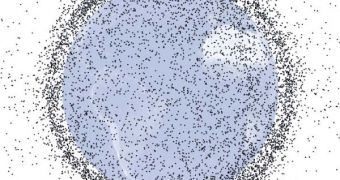With the advent of the Space Age, numerous spacecraft have been sent up to orbit over the years. Some of them are still functioning to this day, relaying back useful information to their control stations on Earth. But many of them are slowly decaying, out of commission, and are littering precious orbital paths, which may be used by new, more advanced systems. At this point, small satellite launches are adding more and more junk to the orbit, and weapon-firing tests that destroyed satellites, as well as the collisions between two such spacecraft earlier this year, have only made things worse, Space reports.
In truth, there are currently tens of thousands of pieces of debris in the Earth's orbit, traveling at enormous speeds, and posing a very real risk to functioning space equipment. At the recent Space 2009 Conference and Exposition, in Pasadena, California, an entire session was themed “Green Space: Addressing Space Debris – End of Life Operations.” Within it, experts tried to assess possible solutions for cleaning up the upper portions of the atmosphere, where a large number of debris spinned.
One of the worst cases of space pollution took place in January 2007, when China showcased its anti-satellite weapon, by blowing up one of its own instruments. In addition to proving that the country indeed had the capabilities it boasted, the explosion served to litter the orbit with thousands and thousands of small debris fragments, which have been posing a terrible risk to the structural integrity of spacecraft trying to get to the International Space Station, the Moon, Mars, or anywhere else, to this day. ESA, JAXA, NASA, and RosCosmos are the main operators of such vehicles.
The main problem with orbital debris is that there is always the risk of a cascade effect, in which a satellite gets hit by debris, its debris hits other satellites, and the cycle then self-propagates around the globe, causing massive amounts of fine junk to cover all possible orbits. This would essentially mean that a shuttle, for instance, would no longer be able to get off the ground, as it would be destroyed upon reaching its designated altitude.
“When we do long-term projections of the space debris environment, it turns out that space debris mitigation measures will delay, but not prevent, collisional cascading from happening in the low Earth orbit regime. This is even so if we stop all launching activities right now (...) once that [cascading] process has started there is no way of controlling it again,” Heiner Klinkrad, who is the head of the European Space Agency (ESA) / European Space Operations Center's (ESOC) Space Debris Office, in Darmstadt, Germany, says.

 14 DAY TRIAL //
14 DAY TRIAL //